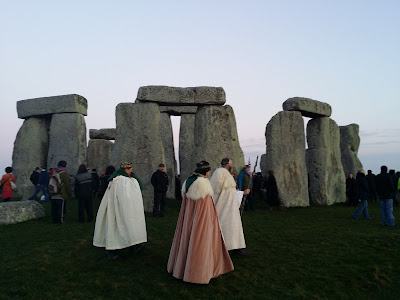Do
you want to add another person to your family? If you're trying for a baby or
you've been experiencing fertility problems, why not have a holiday near Stonehenge and
take in the magic and mysticism of the area?
The History of Stonehenge
Stonehenge, one of the most iconic monuments in Britain, dates back more than 4,500 years to around 2,500 BC. It was built in stages, the latest of which was constructed in about 1,500 BC so its construction spanned both the neolithic and bronze age periods.
For centuries the ancient stones have ignited debate and controversy as to what they were actually used for. There was the suggestion that Stonehenge was a Druid Temple but this is inaccurate as it began to be built 2,000 years prior to the Druids, although modern-day Druids flock there to perform ceremonies. Recent discoveries of hundreds of pieces of bone of various ages dating back more than a thousand years suggest that the monument could have been a temple celebrating the dead, surrounded by a burial ground.
As death and birth are inexplicably linked - both are transition stages for the soul. Near-death experiencers often describe being in a dark tunnel and travelling towards a bright light, a situation that has certain parallels with birth, where the baby moves through the birth canal, to be delivered into a world of brightness and colour far removed from the murky, all enveloping darkness of the womb.
A Celebration of Marriage of the Gods
Professor Meaden, an archaeologist from Oxford University, suggested that Stonehenge may have been used to celebrate the marriage of the pagan Sky God and the Great Goddess. He postulated in his book, 'The Stonehenge Solution' (1992) that the horseshoe arrangement of the inner stones symbolised the womb of the Great Goddess, the Heal Stone represented her body and in order for the Sky God to have physical union with her, the sun's rays had to pass the Heal Stone. Meaden argued that immediately after an unobstructed sunrise, the Heal Stone eclipsed the sun, creating a long shadow that represented the phallus of the Sky God. This long, phallus-shaped shadow eventually extends to the Altar Stone, a stone he believes should have been named the Egg Stone as a representation of the female ova. As the morning arrives, the mica containing stone sparkles in the sunlight, symbolising ejaculation as the phallic shadow disappears. Essentially, this once annually natural spectacle symbolised celestial intercourse. Visitors still gather around the stone circle during the summer solstice to witness this sexually charged fertility ritual.
The Stone Circles: An Analogy with Female Genitalia?
Anthony Perks, a Canadian Researcher, suggested that the stones were laid out in the shape of the human vulva. When a baby's head crowns during childbirth, the vulva is moulded into a circular shape due to pressure from the head - the same shape as the outer ring of stonehenge. All of the stone arrangements could be sexual symbolism. The outer circle could also represent the labia majora, the inner circle of trilithons, the labia minora and the altar stone could be symbolic of the clitoris. The empty centre of the stone circle may represent the birth canal - the opening to the world. At the recently discovered Woodhenge - a wooden version of Stonehenge - the body of a child was discovered buried in the central circle with its skull split in two, a sacrificial offering that would suggest the analogy of the central circle with the birth canal is correct and the child may have been a gift to 'Mother Earth'.
Every Year, Thousands Flock to Stonehenge
Stonehenge's connection with life cycles and fertility is one of the reasons why it attracts couples wanting to start a family. Of course, there's no evidence that visiting the stone circles would help you conceive but soaking up the energy and ancient wisdom of your ancestors may help relieve stress and help you to keep a positive outlook, factors in themselves that can increase pregnancy rates.
The site also attracts pagans and those with 'New Age' philosophical beliefs, but just about everyone - even famous guests like President Obama - love the atmosphere and mystery surrounding Stonehenge. Why don't you give it a try?
Stonehenge Tourist Guide



